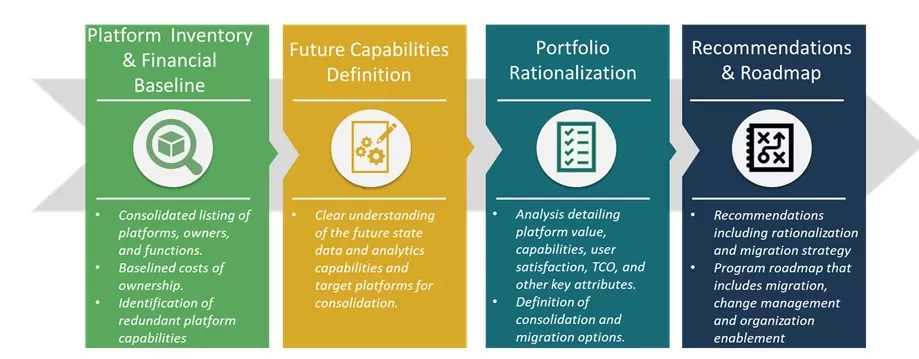Navigating Turbulent Times: Strategies for Analytics Platform Optimization
Challenges and Opportunities: Understanding the Landscape
Initial Steps towards Optimization: Assessing Your Analytics Platform
What is important to many organizations during challenging financial times? In many cases, it is cost reduction and containment, as well as having access to the best data and information to make the organization’s most important business and financial decisions. This first post will discuss the challenges that exist for many organizations that unnecessarily drive-up analytics platform costs and what can be done to reduce these costs while improving the organization’s data analytics and decision intelligence capabilities.
Constrained Budgets and The Need for Decision Intelligence
As belt tightening begins for many organizations, many leaders are being challenged to decrease their analytics platform and related infrastructure budgets, while also being tasked with improving the organization’s decision intelligence capabilities that support accurate business decisions. These two objectives may be seen as conflicting because one might assume that implementing enhanced decision intelligence capabilities would require additional investments. This may be true; however, such investments often drive opportunities to reduce costs that more than justifying the investment. If fact, initiatives focused on platform rationalization and modernization actually work toward satisfying both objectives.
Introduction: The Importance of Analytics Platform Optimization
The Current Landscape: Challenges and Opportunities
Assessing Your Analytics Platform: Initial Steps towards Optimization
Key Considerations for Cost Reduction and Optimization
Understanding the Challenges: The Impact of Turbulent Times
Identifying Opportunities for Cost Reduction and Optimization
Assessing Your Analytics Platform: Key Metrics and Indicators
Developing a Strategy: Steps towards Cost Reduction and Optimization
Common Analytics Platform Challenges
The challenges that many organizations face include ownership and support of multiple analytics platforms that support the same capabilities, platforms that lack modern BI capabilities, legacy platforms that have exceeded or are approaching end-of-life, and IT-dependent analytics platforms that require long cycle times to produce needed insights. These challenges are very costly to the organization and the longer they are left unaddressed the higher the cost to mitigate. While these challenges are typical of organizations that haven’t maintained platform lifecycle management best practices, they are not uncommon.
Where to Start
So how can organizations address such challenges, while lowering related costs and improving the organization’s insights and decisioning capabilities? The first step is to look at the analytics ecosystem holistically through a structured process that serves to evaluate current capabilities, understand technology platform usage and costs, and identify duplicative capabilities and platforms. This review is then followed by a process to define current and future business needs and identify gaps in existing capabilities and technologies. These steps define areas of opportunity where modernization, optimization and rationalization will benefit the organization. This structured process must identify baseline costs across operational processes, license costs, infrastructure and related human capital costs. This total cost of ownership analysis will help to justify new rationalization, modernization and migration initiatives that will drive tangible value.
Illustration 1 – Analytics Platform Rationalization and Migration Process

From a cost reduction standpoint, organizations will typically benefit the most from rationalizing their platform technology footprint. The big challenge with rationalization typically is not determining the platforms that need to be retired or even determining the platform(s) the organization should consolidate to. The more complex consideration is often how existing reports, dashboards, ETL workflows, and data architecture can be migrated to these target platforms at reasonable costs. In fact, the complexity and costs related to migrating and optimizing is why most organizations have remained on legacy platforms as long as they have. Many organizations have accumulated hundreds and thousands of reports and dashboards with related data sources and complex data transformation workflows. Further, each legacy BI platform is unique in its design and technical architecture, thus requiring a unique report migration path to a new modern platform. Without an automated and/or semi-automated way of migrating these assets, costs can often be prohibitively expensive.
Baselining Current Costs and Justifying Migration
Again, baselining the current costs of redundant platforms and capabilities, including licensing costs, infrastructure costs, management costs and ongoing IT development costs is important to recognizing the cost reduction opportunity that can be used to justify the cost of your migration and optimization program. Further, organizations can often identify costs associated with poor or unsupported decision-making capabilities, slower time to market, and IT-led manual data aggregation and analytics development. Taking this step in the process supports the business case required for program approval and allows the organization to measure the initiative’s value.
Options for Consolidation, Optimization, and Re-engineering
Our next post will discuss what options exist and what must be considered as part of the migration effort to consolidate, optimize and/or re-engineer data architecture, ETL workflows and analytics reports and dashboards to target platforms.











 Media Coverage
Media Coverage Press Release
Press Release
